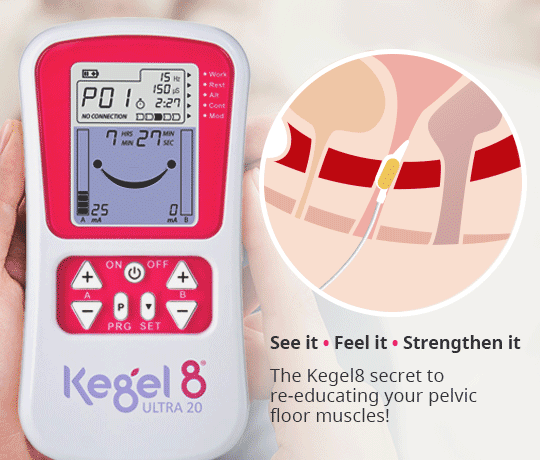- More Effective Pelvic Floor Exercises Condition Guide
- Bladder Weakness & Stress Incontinence Condition Guide
- Uncontrollable Gas/Wind & Lack of Bowel Control Condition Guide
- Perimenopause, Menopause & Post Menopause Condition Guide
- Pelvic Organ Prolapse Condition Guide
- Postpartum Recovery Condition Guide
- Vaginal Looseness & Lack Of Sensation Condition Guide
- Rehabilitation After Gynaecological Surgery Condition Guide
- Pelvic Pain Condition Guide
Discover more effective pelvic floor exercises in just 12 weeks, with the help of the Kegel8 Ultra 20 & Amanda Savage!
Amanda Savage is one of the UK’s leading specialist pelvic floor and women’s health physiotherapists. With over 20 years’ experience offering supervised pelvic floor muscle training and support for the recovery of pelvic organ prolapses, incontinence and pelvic surgeries, she also has post-graduate qualifications, including a master’s degree from the University of Cambridge, and is a member of the Professional Network of Pelvic, Obstetric & Gynaecological Physiotherapy (POGP). Working alongside us for many years in the development of our best-selling device, the Kegel8 Ultra 20 V2 Electronic Pelvic Toner, to ensure its efficacy, she continues to be an ambassador of our brand. An integral part of ensuring all supporting information and instructions are medically accurate so that the device is used correctly/effectively, she has also created 9 exercise guides that utilise a unique combination of the pre-set programmes to ensure treatment is tailored to the specific condition of the user.
Find out more about Amanda Savage, her qualifications, experience, knowledge, and affiliations here.

This tried and tested 8-week exercise programme has been created by Amanda Savage. It designed to ensure optimum treatment for your specific condition using the Kegl8 Ultra 20 V2 Electronic Pelvic Toner.
Please Note: Before proceeding with any of these condition exercises, make certain to run built-in programmes P01 and P02. These are sensitivity tests to help you determine if it’s safe for you to move forward with the following exercise.
Pelvic Pain
Amanda Savage has segmented the treatment options for pelvic pain into 3 areas: relaxation, pain relief and awareness. The aim is to relax the muscles and bring more blood flow to the area, then target the pain relief, and finally enable the user to find and feel their pelvic floor muscles. The first two sections specify the combination of programmes that should be used, and the final section details an 8-week exercise plan. The treatment plan has been specifically created for those suffering with pelvic pain or anal or vaginal discomfort (including tightness and endometriosis. Developed to improve strength and tone in the muscles so that they support the bladder and bowel without experiencing pain, discomfort or tiring easily, it also encourages the muscles to relax. Muscles that work too much without being rested and stretched can become short or “tight”. Follow this plan to practise awareness of both contracting and relaxing the pelvic floor muscles and activate helpful chemical reactions in the brain, which help to reduce pain.
Relaxation
Goal: To relax your pelvic floor muscles and bring blood flow to the area.
Use P20: with vaginal probe 20 minutes of low-frequency current, in two 10 minute phases to improve awareness of the muscle position, blood flow to the tissues, and nerve sensitivity. Lie down and relax as the low-frequency stimulation brings blood flow to the area.
- Phase 1 - Sensations will come and go in short 3 second cycles with 7 second rest periods. Take time to notice the sensations sent to your brain from this area. You may find that you get “used” to the sensations after 5-10 minutes and can turn the mA up a little higher. Aim for a strong but comfortable sensation.
- Phase 2 - Sensations will be continuous. Start to notice all of your body, try to relax your shoulders, legs and back muscles too. 20 minutes is a good time to boost blood flow while you switch “off” your body tension. It will be difficult at first! You might consider combining this pelvic floor programme with a mediation or mindfulness practise (before or after) if you know that relaxing is something you need to “learn” to do.
Use P19: with vaginal probe or surface electrodes 60 minutes of continuous low-frequency current if you want to relax for longer without a change of phase.
Pain Relief
Use P18: Use with surface electrodes. This is the same setting as you’d find on a transcutaneous electrical nerve stimulation (TENS) machine, a device similar to STIM, which is frequently used as an alternative to medication. This helps relieve the type of pain often associated with periods, vulvodynia, and general pain in the pelvic area. The high frequency electrical current diminishes your awareness of sensations coming from other places in your body. This stimulation programme is applied to the skin surface using the electrode pads on your back.
Use P19: with vaginal probe or surface electrodes This programme has a similar effect and purpose but uses a different physiological effect to P18, (termed acupuncture-like TENS) The LOW frequency electrical current stimulates the release of pain-relieving chemicals from your brain. It can be applied with skin electrodes or the internal vaginal electrode if this feels right for you. A continuous low-frequency current improves awareness of the muscle position, blood flow, and nerve sensitivity. Relax completely for up to 60 minutes.
Use P20: with the vaginal probe. This programme has 2 phases. It can help to relieve the pain caused by overworking your muscles, especially if you feel you want to turn them off. This type of pain often feels like a burning or sharp sensation.
- Phase 1 - 10 minutes of work/rest pattern to help you learn better when you are contracting your muscles and to notice when they are relaxing. Be mindful of the sensations and try to work with the machine to practise both skills.
- Phase 2 - 10 minutes of continuous low-frequency current improves awareness of the muscle position, blood flow, and nerve sensitivity. Relax completely.
Awareness
Goal: Exercise to find and feel the pelvic floor muscles
Week 1 - Use P06: This 20-minute muscle exercise programme features long recovery rests between muscle contractions. Allow the sensations to come and go in cycles of stimulation and rest periods and aim to learn where your pelvic floor muscles are. Use every other day as you get used to the probe.
Week 2 - Use P06 If week 1 has been comfortable, use your stimulation device daily for 6 days, then have a rest day. Take an additional rest day if you are at all uncomfortable. If tender or irritated, continue in an alternate day pattern.
Week 3 & 4 - Use P10 in 2 phases:
- Phase 1 - 10 minutes of continuous low-frequency current improves awareness of the muscle position, blood flow, nerve sensitivity. Relax in this phase.
- Phase 2 - 30 minutes at medium frequency current to stimulate the fast and slow pelvic floor muscle fibres by contracting for 5 seconds then relaxing for 5 seconds in cycles. Help your brain to learn what to do by joining in with some of these contractions, trying to contract for the entire 5 seconds. Don’t worry if you can only join in for the first few seconds - let the machine do the rest of the work. Try to relax completely for the full 5 seconds between the contractions and take breaks whenever you feel tired. If these contractions feel too “quick”, stay a week or so longer with PO6. Use 6 days out of 7 (or alternate days if your internal tissues are sensitive).<.li>
Week 5 – Week 8 - Use P11: Join in with some of the contractions in both phases. Still paying lots of attention to relaxing fully between each contraction.
- Phase 1 - 10 minutes: focus on the back area of the pelvic floor (as if stopping wind).
- Phase 2 - 30 minutes: when you join in try to use ALL of the muscle, the back area, the front around the bladder tube and even the side walls! Then use P19 Finish your sessions with 10-20 minutes relaxing with the circulation programme.




